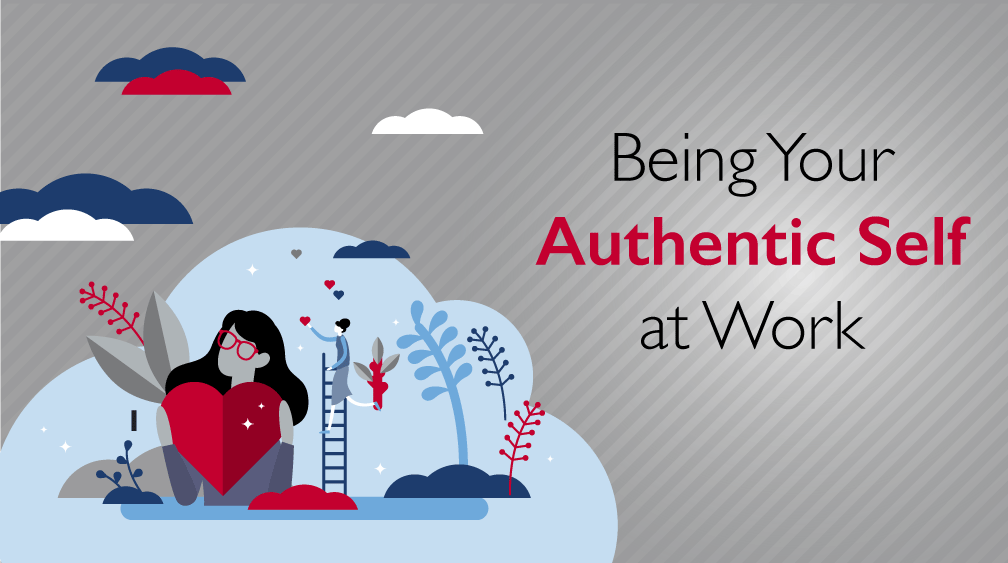At The Clearing, we promote bringing your whole, authentic self into the workplace. This is a wonderful concept and, in reality, it is a complex concept to navigate. Our ability to feel comfortable in bringing our whole selves to work can be affected by who we are, how we look, and our dating preferences – even within an organization that promotes diversity and strives for inclusion.
Humans are social creatures: we have a fundamental need to feel included. Sometimes in an effort to feel included by colleagues, individuals choose to bring their inauthentic self in the workplace for fear of being rejected or seen as unprofessional. It is important to be aware that your organization may foster a culture that triggers these insecurities even if we think our organizations are inclusive. If our colleagues feel there is a risk of being seen as unprofessional based on their authentic expression of self, there is more work to be done.
Constantly switching between our authentic and inauthentic selves is exhausting, contributes to burnout, and limits innovation*. Imagine how much time, creativity, and original thought we can gain as people and as organizations if we celebrated and made space for everyone’s true authentic self.
The solution is not to promote commonality. Instead, organizations must find opportunities to promote, expose, and celebrate differences. The inability to acknowledge differences reduces the ability to recognize discrimination. Organizations interested in creating a diverse and inclusive environment must take an honest look at their culture in order to address what everyone can do to enable lasting change.
Here are three steps you and your organization can take to create awareness of and make space for our authentic selves in the workplace.
Three Steps You Can Take to Make Space For Our Authentic Selves
It starts with you. Are you truly bringing your authentic self to the workplace or are there pieces of your identity you are hiding or downplaying? By recognizing your own differences, you can reveal which parts of your identity are not welcome in your organization’s culture. Next time you find yourself pausing or evaluating your language choices in order to conform, don’t second guess yourself. By allowing more of your authentic self to shine with your colleagues, you may encourage others to do the same.
 Draw the Line. Culture is not right or wrong. Culture is simply a line separating the behaviors we tolerate from those we do not. Organizations must examine how their workplace culture may pressure employees to hide their authentic selves. Get your organization together and draw a line. Ask your colleagues to honestly record the behaviors above the line that are tolerated and those below that are not. You may be surprised by what is reported. This is not an easy exercise but a necessity to get a holistic view of your current culture and what needs to shift in order to create a more inclusive environment. (See: CULTURE PRIME (left). The PRIMES© are documented in the book, The PRIMES: How Any Group Can Solve Any Problem, (John Wiley & Sons, Inc., copyright © 2012) authored by Chris McGoff, founder of The Clearing.)
Draw the Line. Culture is not right or wrong. Culture is simply a line separating the behaviors we tolerate from those we do not. Organizations must examine how their workplace culture may pressure employees to hide their authentic selves. Get your organization together and draw a line. Ask your colleagues to honestly record the behaviors above the line that are tolerated and those below that are not. You may be surprised by what is reported. This is not an easy exercise but a necessity to get a holistic view of your current culture and what needs to shift in order to create a more inclusive environment. (See: CULTURE PRIME (left). The PRIMES© are documented in the book, The PRIMES: How Any Group Can Solve Any Problem, (John Wiley & Sons, Inc., copyright © 2012) authored by Chris McGoff, founder of The Clearing.)
Tackle Underrepresentation. One of the reasons employees feel pressure to suppress their authentic selves is the chronic problem of underrepresentation. When an organization, department, or project team all look and feel the same, the slightest variation is more noticeable. Promoting representation at all levels of the organization will make cultural and authentic selves more normative. However, diversity for the sake of increasing diversity without an environment of inclusion is bound to fail. It is important to uphold consistent standards and expectations that allow employees of all identities to succeed.
Fostering a culture of diversity, inclusion, and authentic self is difficult. There is no perfect solution or approach. By taking the time to listen to your colleagues and address behaviors that could cause individuals to feel uncomfortable being their authentic selves, your organization is one step closer to creating an inclusive environment and reaping the benefits of authenticity in the workplace.






 The Clearing’s Employee Experience
Improvement model, adapted from Itam
& Ghosh, 2020, focuses on three objectives:
The Clearing’s Employee Experience
Improvement model, adapted from Itam
& Ghosh, 2020, focuses on three objectives: 














